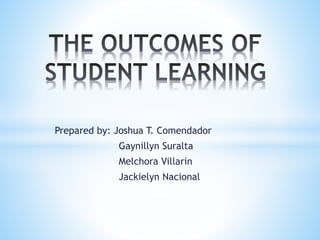
The outcomes of student learning
- 1. Prepared by: Joshua T. Comendador Gaynillyn Suralta Melchora Villarin Jackielyn Nacional
- 2. Student learning outcomes clearly state the expected knowledge, skills, attitudes, competencies, and habits of mind that students are expected to acquire at an institution of higher education. • Specific to institutional level and/or program level. • Clearly expressed and understandable by multiple audiences. • Prominently posted at or linked to multiple places across the website. • Updated regularly to reflect current outcomes. • Receptive to feedback or comments on the quality and utility of the information provided.
- 3. Sample Expected Learning Outcomes Statements : MATHEMATICS Upon successful completion of Math 112 - Pre-Calculus, students will be able to: • Demonstrate algebraic facility with algebraic topics including linear, quadratic, exponential, logarithmic, and trigonometric functions, • Produce and interpret graphs of basic functions of these types, • Solve equations and inequalities, both algebraically and graphically, and • Solving and model applied problems.
- 4. Three types of learning outcomes: COGNITIVE -> referring to acquired mental skills PSYCHOMOTOR -> referring to acquired manual or physical skills AFFECTIVE -> referring to acquired growth in feeling or emotion
- 5. Referring to mental skills.
- 6. BUILDING (ex. Compose,design,plan) JUDGING (ex. Criticize, defend, evaluate) SEPARATING (ex. Analize, compare, distinguish USING (apply, change, compute) COMPREHENDING ( explain, interpret) RECALLING (define, describe, identify LEVELS OF COGNITIVE DOMAIN LEARNING OBJECTIVES ARRANGED HIERARCHY
- 7. Referring to manual or physical skills
- 8. CATEGORIES/LEVELS OUTCOMES VERBS OBSERVING Watch, detect, distinguish, differentiate, describe, relate and select IMITATING Begin, explain, move, display, proceed, react, show, state, and volunteer PRACTISING Bend, calibrate, construct, differentiate, dismantle, display, fasten, fix, gasp, grind, handle, measure, mix, operate, and manipulate ADAPTING Organize, relax, shorten, sketch, unite, re-arrange, compose, create, design and originate
- 9. Deals with situations emotionally such as feeling, appreciation, enthusiasm, motivation, values and attitude
- 10. LEVELS OF AFFECTIVE DOMAIN LEARNING OBJECTIVES ARRANGED HIERARCHY
- 11. CATEGORIES/LEVELS OUTCOMES VERBS RECEIVING Select, point to, sit, choose, describe, follow, hold, identify, name, and reply RESPONDING Answer, assist, comply, conform, discuss, greet, help, perform, practice, read, recite, report, tell, and write VALUING Complete, demonstrate, differentiate, explain, follow, invite, join, justify, propose, report, share, study, and perform ORGANIZING Arrange, combine, complete, adhere, alter, defend, explain, formulate, integrate, organize, relate, and synthesize INTERNALIZING Act, display, influence, listen, discriminate, modify,